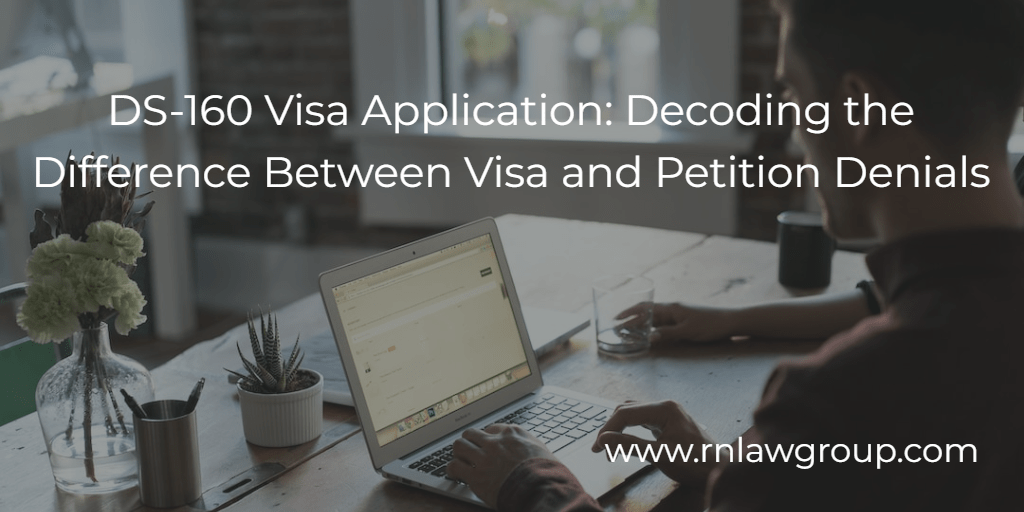
DS-160 Visa Application: Decoding the Difference Between Visa and Petition Denials
In today’s globalized world, navigating the complexities of the DS-160 visa application is a common challenge faced by many aspiring international travelers. The application can often seem daunting and confusing. This is especially true when answering questions regarding previous applications that you may have filed. The good news is, with the right knowledge and preparation, you can effectively manage these hurdles and significantly improve your chances of a successful visa application.
Introduction to DS-160 Visa Applications
The DS-160 form, officially known as the Online Nonimmigrant Visa Application, is a crucial document for anyone seeking to travel to the United States on a nonimmigrant visa. This comprehensive electronic form, required by the U.S. Department of State, collects a range of information, including personal details, travel plans, and background questions, to determine an individual’s eligibility for a U.S. visa. The DS-160 application process is a key step in obtaining various types of visas, such as tourist visas (B-2), business visas (B-1), work visas (H-1B, L-1, O-1, E, TN), student visas (F-1, M-1), and exchange visitor visas (J-1). It’s essential for applicants to accurately complete the DS-160 form as it forms the basis for consular officers to assess and process their U.S. visa applications. This process is integral to ensuring legal and verified entry into the United States for temporary visits, whether for leisure, business, study, or cultural exchange.
Understanding Visa Denials: A Comprehensive Overview
One question on the DS-160 Visa Application often causes confusion: “Have you ever been refused a U.S. Visa, been refused admission to the United States, or withdrawn your application for admission at the point of entry?”
Many people mistakenly think that if they have experienced any kind of denial in the past, they must answer “Yes” to this question. However, not all denials are the same. It is important to be aware that the question uses specific terminology that has specific meanings. Particularly, the first part of the question relates to “visa” refusal.
A “visa” is an official endorsement or stamp placed in your passport by the United States government. This stamp signifies that you have been deemed eligible to enter the U.S. in a specific category, such as tourism, business, study, or work. It’s important to understand that a visa does not guarantee entry into the United States; rather, it indicates that a U.S. consulate or embassy has reviewed your application and determined that you meet the criteria for that particular type of visa. The visa category, which is marked on the stamp, corresponds to your intended purpose of travel, whether it be for leisure (as with a B-2 tourist visa), business meetings (B-1 business visa), academic studies (F-1 student visa), or other reasons. The visa also specifies the validity period, which defines the time frame within which you may seek to enter the U.S. Entry to the country and the duration of your stay are ultimately determined by U.S. Customs and Border Protection officers at the port of entry.
Getting back to the question of whether you have ever been refused a U.S. visa, the question is only referring to a denied visa stamp. For example, if you previously applied for an F-1 visa at a U.S. consulate and the visa was denied because the consular officer was not convinced of your intent to go back to your home country after completion of your studies, this would be considered a visa refusal requiring a “Yes” answer. This would be true even if you later applied again for an F-1 visa and were successful the second time around. For every future visa application, this denial would need to be disclosed.
Exploring Petition Denials: Key Differences from Visa Denials
It is important to distinguish between denials issued by the United States Citizenship and Immigration Services (USCIS) and what constitutes a “visa” refusal in the realm of U.S. immigration. When an application or a petition is denied by USCIS, it does not equate to a visa refusal. USCIS is responsible for processing a variety of immigration-related petitions and applications, such as those for employment authorization, change of status, extension of status or immigrant petitions. A denial from USCIS typically relates to these specific requests and does not directly impact visa decisions, which are under the purview of the U.S. Department of State. Visa refusals, on the other hand, occur during the consular processing stage, specifically when a U.S. consulate or embassy decides not to grant a nonimmigrant visa after reviewing the DS-160 visa application. Understanding this distinction is crucial for applicants navigating the U.S. immigration system, as it affects how one should approach subsequent visa applications.
Navigating the DS-160 Application: Addressing Denials
It is important to understand that the U.S. Department of State is already aware of any prior visa refusal you may have experienced when you are applying for a new visa. Therefore, it is critical that all prior refusals be disclosed on the DS-160 and a brief explanation provided. Answering “No” when a prior visa has in fact been denied can be grounds for misrepresentation and can lead to visa denial. For our F-1 visa example discussed above, after answering “Yes” regarding the prior visa refusal, an applicant could explain that he or she previously applied for an F-1 visa at the U.S. Consulate in Chennai on June 7, 2015, which was denied. A subsequent application for an F-1 visa on July 28, 2015 was approved.
Tips for Avoiding Common Mistakes on the DS-160
It is becoming increasingly common for consular officers to closely examine the information on the DS-160 form, paying particular attention to areas such as educational background and past work experience. These sections are receiving heightened scrutiny, especially as authorities focus on certain educational institutions and businesses known for regulatory breaches or questionable activities. For instance, when filling out the DS-160, failing to list every educational institution attended post-secondary school, even if you didn’t earn a degree from that institution or if the field of study is unrelated to your current job, could result in your application undergoing administrative processing or being denied. Similarly, any gaps or inconsistencies in your five-year employment history, such as discrepancies in job titles, duties, or employment dates compared to what’s listed in approved non-immigrant petitions, might also lead to additional administrative processing. Being thorough and accurate in these sections is crucial to avoid potential delays or denials in your visa application process.
Next Steps after a Denial
If you have experienced a visa denial and/or are considering applying for a new visa after a previous denial, it is important to consult with a qualified U.S. immigration attorney to understand the cause(s) of the denial, whether it can be overcome, and how to address it in future applications.
By: Emily Neumann
Emily Neumann is Managing Partner at Reddy Neumann Brown PC with over 15 years of experience practicing US immigration law providing services to U.S. businesses and multinational corporations. Emily has helped transform the firm from a solo practice to Houston’s largest immigration law firm focused exclusively on U.S. employment-based immigration. She received her Bachelor’s degree in Biology from Central Michigan University and her Juris Doctorate degree from the University of Houston Law Center. Emily is a frequent speaker and has been quoted in Bloomberg Law, U.S. News & World Report, Inside Higher Ed, and The Times of India on various hot topics in immigration. She is a member of the American Immigration Lawyers Association and Society for Human Resource Management.
Reddy & Neumann has been serving the business community for over 25 years and is Houston’s largest immigration law firm focused solely on US. Employment-based immigration. We work with both employers and their employees, helping them navigate the immigration process quickly and cost-effectively.

